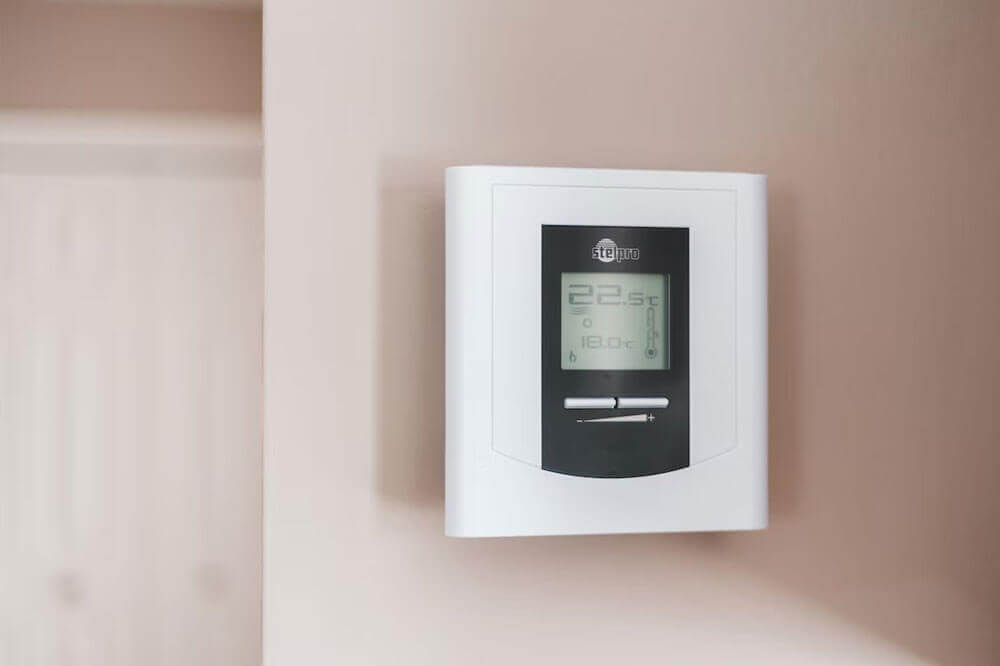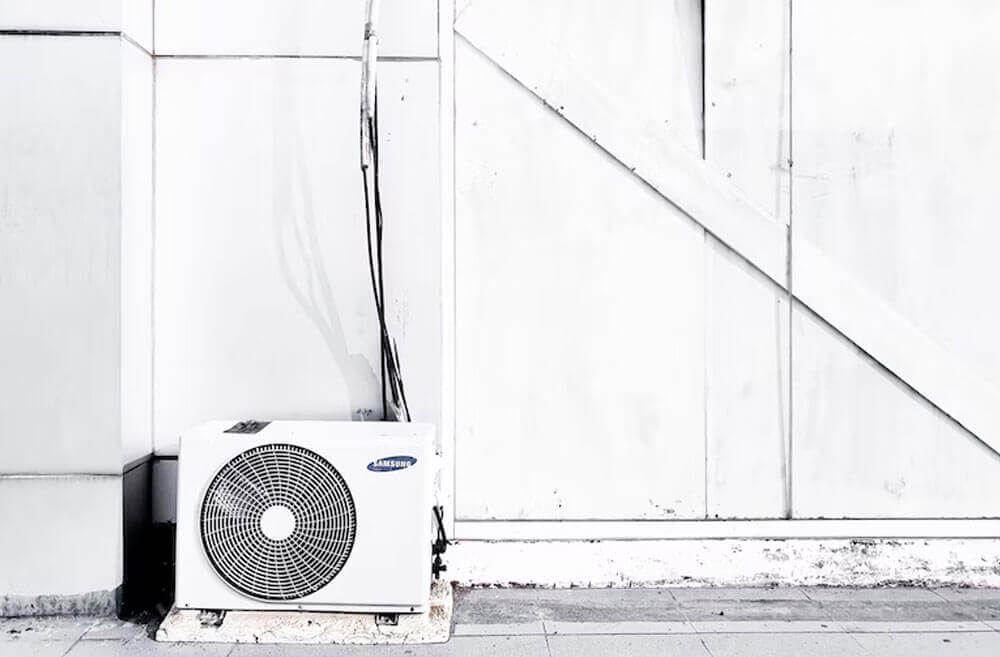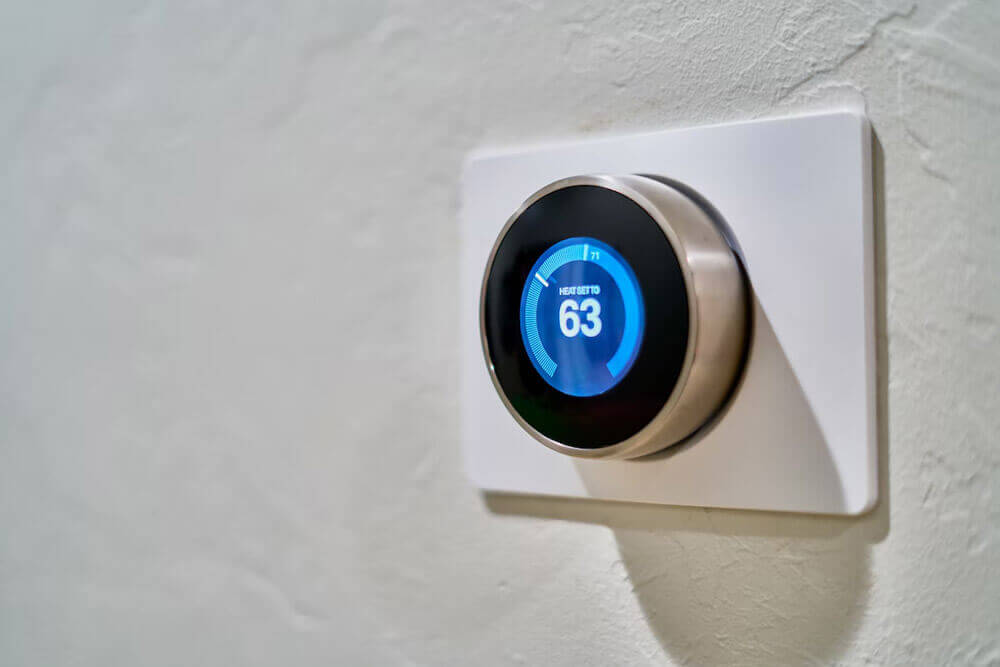By Go Green Heating & Air Staff
Updated August, 2025 | 6-Minute Read
Smart technology keeps making our lives easier, and now it’s helping homeowners stay more comfortable at home. More Denver-area residents are installing smart thermostats and HVAC controllers as opposed to traditional ones because they’re tired of Colorado’s unpredictable weather, forcing them to make constant manual adjustments. They also see the effects it has on their energy bills. Like any technology, smart thermostats have both benefits and drawbacks. Since every home operates differently and budgets vary widely, you need solid information before investing in one of these systems.
As HVAC contractors, we know what works, what doesn’t, and why. Let’s discuss the real advantages and potential disadvantages of smart thermostats so you can make the right decision for your home.
Pros:
1. Energy Efficiency
One of the biggest benefits of smart thermostats or smart HVAC controllers is their ability to optimize energy use. These devices allow users to set the temperature for different times throughout the day. For example, you might set the thermostat to 75 degrees while you’re at work, then have it cool down to 72 shortly before you get home. Over time, the system learns your routine and automatically fine-tunes itself, cutting back on energy use when it’s unnecessary.
Many models also offer zone control, meaning you can fine-tune the temperature room by room. That means less energy is spent heating or cooling areas you rarely use. With the right setup, your system only works when—and where—it really needs to, helping you stay comfortable without running up your utility bill.
2. Remote Operation
Smart thermostats also allow you to control your heating and cooling remotely through a smartphone app or website interface. This allows you to get your heating and cooling on the same page as your busy schedule and adjust it on the fly.
In cases of extreme weather conditions or other unexpected events, you can keep your home safe and comfortable, even if you aren’t present. If you’re away from home for an extended period of time, this also allows you to keep tabs on your HVAC system to ensure it’s working properly while you’re away. Curbing excessive energy consumption is much easier with the remote control, and it can be used to really focus on your schedule to optimize that important energy efficiency.
3. Programmable Schedules
While not everyone might be wild about setting up different schedules, these can be a great feature once you get them programmed to your specifications. Every family has different, busy schedules, and you can tailor your home’s comfort to your lifestyle. Lower the temperature when everyone is at work or school, and make it more comfortable when most or all of the family is at home.
It’s already been mentioned how these programmable schedules can help with energy efficiency, but they can also be detailed right down to the days of the week. Once these schedules are set, you’ll be back to the “set it and forget” mode that you were used to with more traditional thermostats. The difference is that these schedules are more detailed, allowing you to have optimal comfort without constantly tinkering with it every time someone seems chilly. Zero in on the right temps for the right times of day, and everyone in the family should feel optimal comfort without wasting any energy.
4. Data Insights
Smart thermostats will also gather and store data on your energy usage. This can help you track patterns and potentially identify ways to even further improve your energy efficiency. These will tell you when you’re using the most energy and how much is being used when nobody’s home. Understanding these patterns can help you make more informed decisions about energy-saving opportunities to take advantage of by altering your thermostat or schedules.
These data insights can also help smart thermostats identify when there might be abnormalities in your HVAC system’s performance. Many of these programs can provide alerts or notifications when something changes within the system. This can include excessive or abnormal runtime, uncommon temperature fluctuations, or even some equipment malfunctions. By identifying these problems early, the consumer might be able to address them before the issue escalates into costly repairs or system failures.
Cons:
1. Con: Higher Upfront Cost
While these systems might be able to save you some money in the long run due to the energy efficiency, one of the drawbacks is a higher upfront cost compared to more traditional thermostats. That makes this type of system an investment, and that investment will fluctuate depending on how advanced of a model you want to purchase and install in your home.
Basic models still have essential features that allow you to schedule heating and cooling based on your schedule, but some more advanced models are required if you need additional sensors, integration with your current system, or other energy-saving features like zoning. There is no denying the potential for savings on energy bills, but it may take a while to recoup the initial investment. That can be a turnoff for some people, depending on their current financial situation and budget. Check with your trusted HVAC professional to find out what system might be the best for your individual situation.
2. Complexity
There are a lot of different things smart thermostats and HVAC controllers can do, particularly through the app on the smartphone or web. However, some of these things might seem complex to some users that are more comfortable dealing with more traditional thermostats. These systems can take some getting used to, and may need more attention while you’re dialing in the system to your individual preferences.
There are a multitude of features and settings with smart thermostats, and those can get overwhelming for those who prefer simplicity. In time, the smart thermostat won’t require as much attention – when it understands and works within your desired specifications – but there can be a learning curve right after it’s installed. There are a number of benefits to the advanced features and customizable options with smart HVAC controllers, but some may find them overwhelming. There will likely be some form of technical support to help with these questions, but it can still be frustrating for those who aren’t tech-savvy.
3. Must Have Internet Connectivity
Smart thermostats feature handy mobile applications and web interfaces to allow you to set the right comfort level for any time of day. However, those features rely on being connected to the internet. Without a stable internet connection, those apps won’t function properly, and that could cause an interruption in those remote capabilities until service is restored. This might seem like a marginal inconvenience, but it’s important to recognize in case there’s a loss in service for an extended period of time.
These types of thermostats can also be integrated with other smart home devices and systems, and a lack of internet connectivity can break the communication between these devices. Most systems have protective measures in place, but because the system is connected to the internet, there is a chance of cybersecurity threats. Internet connectivity adds convenience and functionality to the whole system, but it’s important to understand that there are potential risks.
4. Compatibility
Not all HVAC systems are compatible with smart thermostats. Older systems or those with proprietary protocols may not work with certain models, requiring additional equipment or professional installation. Another example of compatibility issues might be that a smart system won’t work with a system that uses high-voltage wiring. Because of the aforementioned internet connectivity, your home Wi-Fi network must also work within the smart thermostat’s system requirements.
Over time, the software for your smart thermostat will also require upgrades. There is a chance this may change the compatibility requirements from the manufacturer. Not all manufacturers are created equal, so it’s crucial to make sure you choose a smart thermostat from a reputable source that provides regular updates and support to address these compatibility issues.
The convenience and functionality of smart thermostats are unparalleled, and the technology is improving every day. There might be a learning curve to having a smart thermostat in your home, but there are a lot of benefits once it’s running based on your conditions. For more information on smart thermostats and how they work, reach out to the experts at Go Green Heating & Air Conditioning today.
Related Questions
What is a programmable thermostat?
A programmable thermostat, or smart thermostat, allows you to set specific temperature schedules for your home’s heating and cooling system. Instead of manually adjusting the thermostat every time your routine changes, you program it to automatically raise or lower the temperature at different times of the day or week.
How does a programmable thermostat work?
Programmable thermostats use an internal sensor to monitor the current room temperature and compare it to the programmed settings. When the temperature falls outside your preferred range at any programmed time, the thermostat signals your heating or cooling system to turn on or off to reach the targeted temperature. That automation keeps your home comfortable without constant tinkering. And by reducing unnecessary heating or cooling, it can help lower your energy bills over time.
What features should I look for in a modern programmable or smart thermostat?
In short, focus on features like customizable schedules and remote control. Just as important: make sure the thermostat is compatible with your HVAC system. You might also consider extras like learning capabilities that adjust to your routine, geofencing that uses your phone’s location to shift settings automatically, and voice assistant support. Add-ons like multi-room sensors, energy reports, and maintenance reminders can improve comfort and efficiency. And don’t overlook the basics. Easy installation and a user-friendly interface go a long way.
About the Author
Denver Heating & Air Conditioning has served homeowners throughout the Denver metro area with professional HVAC installation, repair, and maintenance services for over 20 years. Our team includes NATE-certified technicians who specialize in indoor comfort solutions, energy efficiency, and whole-home air quality.





